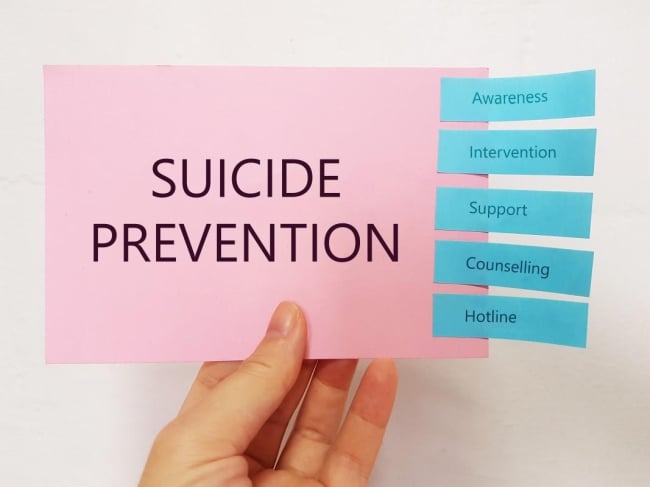You have /5 articles left.
Sign up for a free account or log in.

WPI has been shaken by seven student deaths, including at least three by suicide, in less than a year.
iStock/Getty Images Plus
Seven student deaths in the last eight months have left the Worcester Polytechnic Institute community grief-stricken. Compounding that tragedy is the fact that at least three of those lives were lost to suicide; two deaths are under investigation, according to the university.
“Certainly any loss of a student is devastating,” said WPI president Laurie Leshin.
Three deaths by suicide in the span of a year is staggering for a campus that has seen two student suicides over the past 15 years. Now WPI—which has a total enrollment of around 7,000—is mourning but also looking for a way forward, working to identify student mental health needs and provide services as these tragedies reverberate across campus and beyond, with students nationwide facing mental health challenges exacerbated by the COVID-19 pandemic.
“We have been working very closely with families, with the students who are closest colleagues with the students we’ve lost, to make sure that they are receiving personal and extensive support,” Leshin said. “And then we are looking more broadly at our community’s well-being and working to understand where the issues are and how to address them.”
What’s Happening at WPI
Students describe a somber, almost eerie feeling on the Massachusetts campus, where grief hangs heavy in the air. Some point to the striving culture, the constant grind, the academic pressure at WPI as a source of distress—an issue that a report from the university also identified as significant.
Jack Baker, a senior engineering major, said he has had his own experiences with despair, attempting to end his own life multiple times. Even after one attempt landed him in a psychiatric hospital, he continued his schoolwork there, which he believes is a testament to the WPI culture.
“I think it comes from the WPI mind-set,” Baker said. “I believe it is an unhealthy frame of mind that students have—it almost feels like a competition. It seems like if you aren’t struggling, you aren’t working hard enough. I believe that’s where most of these problems are stemming from.”
In response to the recent suicides, WPI launched a 35-member Mental Health and Well-Being Task Force comprised of students, faculty and staff. The task force released a report in January; based on student surveys, listening sessions and town halls, and various other inputs, the group identified a number of stressors for both undergraduate and graduate students at WPI.
Students cited academic pressure as a significant challenge, with 82 percent of undergraduates and 65 percent of graduate students reporting “too much academic pressure.”
“WPI is a culture of systemic overwork: individuals feel pressure to do more and more,” according to the report, which goes on to note that students—particularly those who are new to the college—often experience “significant academic pressure in our introductory courses and struggle to manage workload and pace and find appropriate assistance.”
Both undergraduates and graduate students named lack of self-care and balance as another challenge; additionally, graduate students reported that the lack of social connections affected their mental health.
Among the other findings, both groups reported issues such as a lack of resilience, uncertainty about where to find mental health and well-being resources, and inadequate communication about the availability of such services. “Pandemic burnout” also had a moderate impact on undergraduate students’ mental health and well-being, according to the report.
Addressing the Challenges
In addition to identifying the stressors, the report makes a series of wide-ranging recommendations, including teaching academic success skills and self-care to newly enrolled students, better identifying students who are struggling with coursework, and modifying policies and practices in an effort to relieve academic stress. The report also recommends increasing the role faculty members play in dealing with student mental health issues.
While the recommendations above offer only a snapshot of what is in the 28-page task-force report, Leshin says it all comes down to two things: community building and skill building.
“Community building is all about building that circle of support, that circle of friends, making sure that everyone has a sense of belonging on our campus,” Leshin said, adding that despite WPI’s best efforts, it has proven difficult to keep students connected during the pandemic. She hopes the easing of COVID-19 restrictions on campus will help forge student connections.
Skill building, Leshin said, is about helping students find what they’ve lost amid a pandemic that has disrupted social-emotional learning opportunities and prevented them from gaining the maturity that typically comes from being on a college campus. WPI also aims to help students develop impulse control and mental health awareness.
“We know that this moment has been incredibly difficult for our students,” Leshin said.
Beyond enacting the recommendations made in the Mental Health and Well-Being Task Force report, WPI has also added three full-time counselors to its staff at the Student Development & Counseling Center, added off-hours counseling services, engaged an outside firm to evaluate campus mental health practices, held a recent online forum for parents to learn how to talk to their children about suicide and launched a resource page—which extends to WPI social media postings—and a biweekly newsletter focused on mental health and well-being.
When students leave for the summer, Leshin said, counseling will still be available via telehealth.
A National Mental Health Crisis
WPI is hardly the only U.S. campus that has experienced an increase in student mental health issues as a result of the pandemic.
In December, U.S. surgeon general Dr. Vivek Murthy issued an advisory on youth mental health, pointing to “persistent feelings of sadness or hopelessness” and increased suicidal ideation.
“The pandemic era’s unfathomable number of deaths, pervasive sense of fear, economic instability, and forced physical distancing from loved ones, friends, and communities have exacerbated the unprecedented stresses young people already faced,” Murthy wrote.
John Seeley, an education professor at the University of Oregon whose research includes school-based mental health interventions, said the issues that arose during the pandemic are unsurprising given the sudden changes, including social distancing and isolation.
“The additional stressors put on life, and changes in scripted behaviors and expectations, often lead to more mental health issues,” Seeley said. “It’s not surprising that the pandemic would impact the mental health of individuals, especially given that social isolation has been a key way to stem the pandemic. But that also contributes to depression and suicidal ideation.”
He added that the challenges for students are compounded by the fact that many universities “are averse to dealing with the issue due to fear of litigation if they don’t respond in the most appropriate manner.” That often means referring students to outside care providers, which may require more time and money. An additional issue, he said, is the lack of providers amid an ongoing counselor shortage.
Laura Horne, chief program officer at the mental health advocacy group Active Minds, believes that the pandemic is “augmenting the mental health issues that were already there” for students. The one plus side, she noted, is that the pandemic has made mental health struggles more relatable through a widely shared experience, which helps bring those issues into the light.
“Back when I started in the field, a decade ago, it would often take a catastrophic event, like a series of suicides or some kind of optics nightmare, for a college or university to take action,” Horne said. “I think many of us in the field are hoping that the pandemic has made it easier for colleges and universities to take action on this need and actually apply resources to suicide prevention. It’s something that we’ve needed for a really long time, even before the pandemic.”
College Mental Health Efforts
WPI is far from the first campus to experience a series of student suicides. Cornell University has seen student suicides over the years, including a string of such deaths back in 2010. The university has responded by continuing to build out mental health resources.
“For over a decade, Cornell University has utilized a comprehensive public health approach to mental health,” Cornell spokesperson Gillian Smith wrote in an email. “Our campus framework reflects the best practices advocated by the Suicide Prevention Resource Center and The Jed Foundation Model for Comprehensive Suicide Prevention and Mental Health Promotion. It is a population-based strategy to reduce risk factors and enhance protective factors for suicide.”
The University of North Carolina at Chapel Hill also saw two students die by suicide in 2021. UNC responded by offering students mental health days and announcing the launch of the campuswide Heels Care Network campaign “to promote and support mental health awareness.”
Stanford University also saw two student suicides in 2019 but did not respond to multiple inquiries about how it is addressing student mental health.
In the absence of a playbook on how colleges can deal with such issues, experts encourage them to increase resources for mental health but also to change the conversation around it, expanding such issues into broader marketing campaigns focused on overall student health.
Still, there’s work to be done.
“I would like to see colleges and universities apply funding and resources towards mental health in a more preventative way,” Horne said. “And that first prong is definitely shoring up mental health resources and making them more accessible.”
Redefining mental health and destigmatizing such issues is also an important measure.
“A lot of [suicide prevention] is around gatekeeper training and trying to train individuals to identify the warning signs,” Seeley said. “A key issue here is how do we reduce the stigma associated with suicide when we don’t talk about it? When we put our head in the sand and we ignore the problem? We need to destigmatize mental health in general, but suicide in particular, so that we deal with it directly rather than avoiding the topic.”
Baker, the WPI student, recalls discussing his own attempt to harm himself with others while he was in the hospital, an experience he felt reduced the stigma around it and allowed him to open up. Now he hopes others on the WPI campus can have the same conversations and point students in crisis to the mental health resources they need.
“I understand that it may be an uncomfortable topic, but the more you listen, you could actually be saving someone’s life, quite literally,” Baker said. “And I don’t mean to be dramatic or anything, but I firmly stand by the fact that a conversation can save someone’s life.”
The National Suicide Prevention Lifeline is a free, confidential 24-7 service that can provide people in suicidal crisis or emotional distress, or those around them, with support, information and local resources. 1-800-273-TALK (8255).








